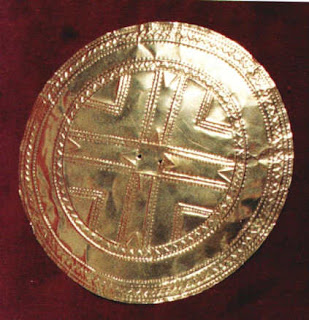Newgrange is one of the most visited archaeological sites in Ireland Stonehenge . The mound is kidney shaped and measures 103 metres in diameter and 13 metres high. Rediscovered in 1699, it lay unprotected and open to the abuses of people and wild animals until it was partially excavated in from 1962 to 1965 by Professor Michael J. O’Kelly. The initial purpose of this excavation was to stabilise the parts of the mound that were in danger and to repair the damage so that the public could continue visiting it. But the work became more extensive and one third of it was fully excavated. It was O’Kelly who first discovered the secret of the Roofbox after he had cleared the opening of soil and debris. He was the first in modern times to witness the spectacle of the rays of the sun penetrate into the passage on the morning of the winter solstice, the shortest day of the year.
The sunlight in the passage on December 21st
At a glance, Newgrange is a most magnificent mound, faced with white quartz stones and river washed granite boulders but on closer inspection it opens up a doorway to Stone Age life and some of its most hidden secrets. The sheer dedication and attention to detail of that community has left us in awe of their intelligence. For the mound had to be planned years in advance of building it, so that the passage was lined up with total accuracy so that the sunlight would creep up the passage at exactly the right time. The passage had to be created on an incline to allow the light to enter the roofbox and reach all the way to the chamber almost half way inside the mound.
The chamber itself is a clever piece of engineering with a roof covering it that has not allowed a single drop of rainwater in since its erection. This was made possible overlapping large slabs in gradually decreasing circles to create a domed effect roof. Each slab was placed a slight angle allowing rainwater to safely drain off it into the mound. If these slabs had been placed on top of each other without any cushioning they would have cracked under the weight of the ones above. To solve this layer of smaller stones were placed between the heavier slabs to allow for settling without any damage having been done.
The corbelled roof.
There are 97 kerbstones surrounding the mound but only a few of these are decorated. The principal ones are K1, the entrance stone and K52, the one directly opposite at the back. Designs such as spirals, lozenges and zigzags, have baffled people who have tried to decipher their meanings. From an artistic point of view, these designs are abstract and often geometric, not unlike the ones seen in artwork from this era on the Iberian Peninsula (possibly where these people originated from).
Kerbstone 52
Similar designs are also found on the orthostats that line the passage, and in the chambers that complete its cruciform shape. The cremated remains were placed on stone basins in these chambers possibly lying in wait for the sunlight to penetrate the tomb on the morning of the winter solstice.












